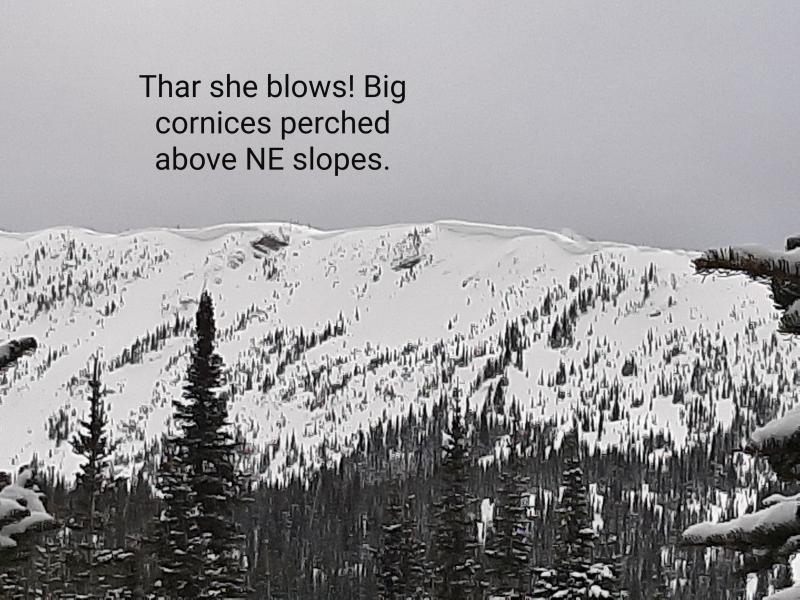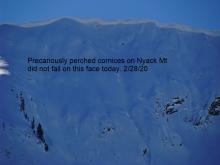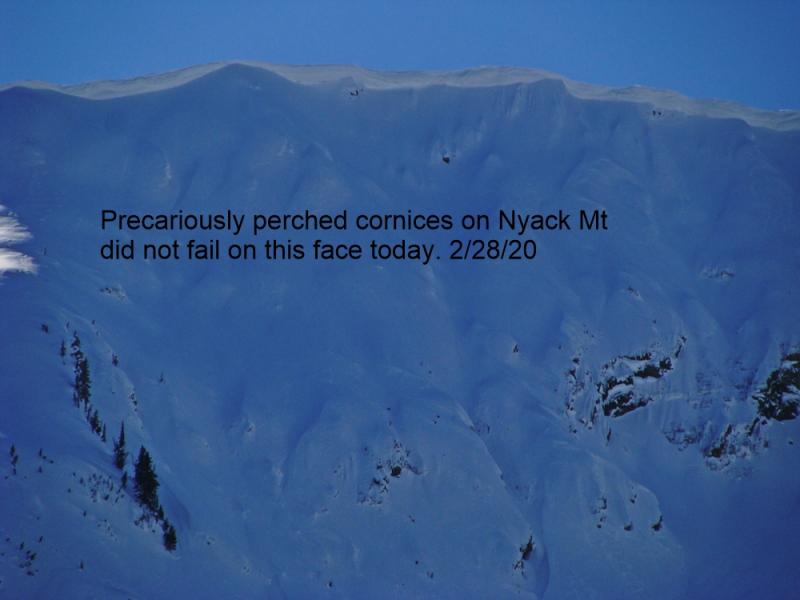| Wednesday | Wednesday Night | Thursday | |
|---|---|---|---|
| Cloud Cover: | Warming temperatures with clear skies. | Clear skies and warm | Ridiculously warm! |
| Temperatures: | 53-64 deg. F. | 30-38 deg. F. | 60-74 deg. F. |
| Wind Direction: | Southwest | Northeast-southeast | South |
| Wind Speed: | 3-5 mph. | 4-7 with gusts to 20 mph in the Flathead Range. | 0-5 mph. |
| Snowfall: | 0 in. | 0 in. | 0 in. |
| Snow Line: |
Whitefish Range
Swan Range
Flathead Range and Glacier National Park
How to read the forecast
Today's well above normal temperatures and sunshine, combined with a poor refreeze of the surface snow, will create wet avalanche problems and dangerous conditions as the day progresses. Wet loose avalanches should be expected on all aspects. This unusual warming will weaken recently formed upper elevation wind slabs along with cornices. Cornice fall could trigger large avalanches on the slopes below. The danger will rise to CONSIDERABLE above 5000 feet and MODERATE below.

3. Considerable
?
Above 6500 ft.
3. Considerable
?
5000-6500 ft.
2. Moderate
?
3500-5000 ft.
- 1. Low
- 2. Moderate
- 3. Considerable
- 4. High
- 5. Extreme
-
Type ?
-
Aspect/Elevation ?
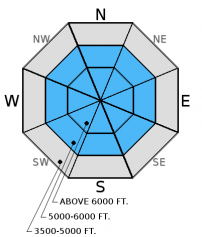
-
Likelihood ?CertainVery LikelyLikelyPossible
 Unlikely
Unlikely -
Size ?HistoricVery LargeLargeSmall

Today should be the start of another multi day wet loose avalanche cycle. Recent snow that fell Monday night into Tuesday occurred at mid and upper elevations and was deposited onto a crust formed from last weekends warm up. Although there is not as much new surface snow as our last wet loose cycle, the temperatures will be warmer, so expect the wet loose problem to extend into higher terrain. New snow only requires a few minutes of the relatively intense April sun to weaken and therefore these slides should start on sunny aspects early today. All aspects at mid and upper elevations will be affected by these unusual weather conditions. Due to the limited amount of new snow on top of the surface crust these slides will start small but as the day progresses, and the surface crust breaks down, the potential exists for larger wet loose slides to occur. The first signs of instability are rollerballs and pinwheels forming on the slopes. When you notice these it is time to move to a more shaded aspect or call it a day.
-
Type ?
-
Aspect/Elevation ?

-
Likelihood ?CertainVery LikelyLikelyPossible
 Unlikely
Unlikely -
Size ?HistoricVery LargeLargeSmall

Today is the start of another warming trend that will weaken the large cornices throughout our advisory area. Recent warm temperatures and sunshine weakened the numerous large cornices in the area (photo). Friday, a cornice fall on Nyack Mountain in the Flathead Range triggered a deeper slab and resulted in a very large avalanche (observation). On Saturday, we witnessed another cornice fall that triggered a wind slab avalanche in the Swan Range (observation and video). On Monday we noted a large slab avalanche which was triggered by a cornice fall on Mt. Cameahwait in the Flathead Range. When they hit the slope these behemoths are capable of triggering even deeper weak layers that would otherwise remain dormant in the snowpack. Cornices can pull far back from behind the ridge line making it important to keep an exaggerated distance away from the edge when traveling above cornices. Avoid traveling on the slopes below cornices as well.
Also, numerous glide cracks exist throughout the advisory area (image) and several have even failed. Whitefish Mountain Resort Ski Patrol reported widening glide cracks on Thursday. Glide avalanches are very difficult to predict, so the best strategy is to avoid playing on slopes where glide cracks exist.
-
Type ?
-
Aspect/Elevation ?
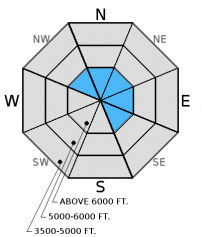
-
Likelihood ?CertainVery LikelyLikelyPossible
 Unlikely
Unlikely -
Size ?HistoricVery LargeLargeSmall

Recently formed wind slabs will also be affected by today's warmth and sun. Recent observations of these slabs referred to them as unreactive and stubborn (observation). As the temperatures warm and solar input increases these slabs will weaken and should become more reactive as the day progresses. In most locations these slabs were deposited onto a crust which is a great bed surface for these to slide on. These slabs can knock you off your feet or machine and push you into terrain traps or stands of trees. In select locations the debris from these avalanches could potentially trigger a deeper instability in the snowpack.
Older wind slabs that formed last week exist across our area. Many of these have gained strength and are not presenting obvious signs of instability. However, cornice falls over the weekend triggered several large wind slab avalanches.
Evaluate all wind loaded terrain today before committing to a slope. Look for smooth rounded pillows on leeward sides of ridges and cross loaded terrain features.
The last advisory of the season will be issued on Sunday, April 10, 2016.
Tuesday: The Going-To-the-Sun-Road avalanche program reported up to 7 inches of new snow at low elevations with small wind slabs forming above 5500 feet. Impressive wet loose debris on all aspects was noted from the weekends above freezing temperatures.
Monday: We travelled to the Tunnel Ridge area in the Flathead Range where we found a thin surface crust at all elevations which broke down by mid morning. We observed the aftermath of the recent wet loose avalanche cycle on all aspects at mid and upper elevations. We noted a large wind slab avalanche triggerred by cornice fall on Mt. Cameahwait (observation).
Sunday: Skiers in the Tunnel/Pinnacle Creek area in the Middle Fork of the Flathead Range reported hearing and seeing numerous natural wet, loose avalanches by 9:00 am. They wisely called it a day and headed home.
Saturday: We were in the Lost Johnny Drainage in the Swan Range. We observed widespread natural loose, wet activity on all aspects and large cornices. In the afternoon, we witnessed a slab avalanche triggered by cornice fall above Lamoose Lake at the head of the drainage (observation, video). On a south facing slope near 7000 feet we found a shallow snowpack that was moist throughout (photo) where there was a prominent crust about 18 inches from the surface that had pooled water above the crust. Skiers on Huckleberry Ridge in Glacier National Park found a variety of crusts in the upper snowpack and stability tests produced fractures nearly a foot from the surface. They noted thick, older windslabs that were minimally reactive in stability tests but produced clean shears (observation).
Friday: Skiers in the Cascadilla Drainage in the Flathead Range reported a large natural avalanche thought to have been triggered by cornice fall (observation). Skiers outside of the advisory in the St. Mary area of Glacier National Park reported multiple natural, loose, wet avalanches on sun exposed slopes that began at about 10:30 am.
Thursday: A skier on Glacier View Mountain in the Whitefish Range intentionally triggered a wet, loose avalanche on a north aspect at 5400 feet (observation). Whitefish Mountain Resort Ski Patrol reported skier triggered loose, wet avalanche (photo) and widening glide cracks. Erich and I observed a softening snow surface on most aspects despite cloud cover in China Basin and Werner Peak in the Whitefish Range yesterday. We did not observe any avalanche activity by mid to late afternoon (observation).
Visit our Observations page and our You Tube channel for more observations from the entire season.
Thanks to everyone for submitting observations. They are extremely useful and could help save lives.
HOW TO SUBMIT OBSERVATIONS:
Email: [email protected]
Call and leave a message: 406.387.3821
You can also submit quick observations via text: 406.241.4571 (FAC mobile)
OR
Submit Snowpack Observations: http://www.flatheadavalanche.org/node/add/snowobs
Submit Avalanche Observations: http://www.flatheadavalanche.org/node/add/avyobs
The heat wave begins in earnest today! Yesterday, temperatures climbed to 37°-45° F with light to moderate winds with an occassional strong gust. Currently, temperatures above 6000 feet range from 33º-37º F and winds are blowing out of the southwest at 5-15 mph with gusts from 14-27 mph. Today, expect a ridge of high pressure to strengthen with temperatures rising to the upper 40s to mid 50s F. Tomorrow will be even warmer with temperatures in the 60s F at upper elevations.
| 0600 temperature: | 33-37 deg. F. |
| Max. temperature in the last 24 hours: | 37-45 deg. F. |
| Average wind direction during the last 24 hours: | Southwest |
| Average wind speed during the last 24 hours: | 5-21 mph |
| Maximum wind gust in the last 24 hours: | 25-39 mph |
| New snowfall in the last 24 hours: | 0 inches |
| Total snow depth: | 79-115 inches |
This advisory applies only to backcountry areas outside established ski area boundaries. This advisory describes general avalanche conditions and local variations always occur. This advisory expires at midnight on the posted day unless otherwise noted. The information in this advisory is provided by the USDA Forest Service who is solely responsible for its content.













